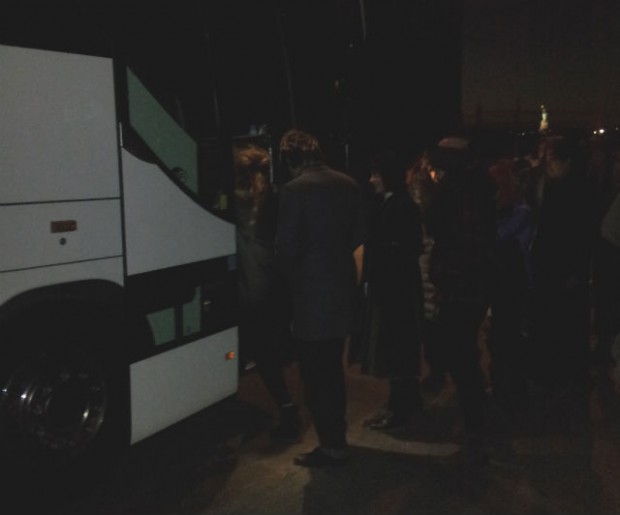This Sunday, my ride in Philippe Quesne’s performance-art tour bus was an experience in sitcom logic. It mimicked the “Mac Day” episode of It’s Always Sunny in Philadelphia where Mac orders his friends to join in his favorite activities; they all grudgingly agree, but only because they’re part of the gang.
I’m not sure why I agreed to Quesne’s tour—I don’t know anything about his gang, or why I’d need to be a part of it—but there’s an expectation with performance art to sit back, enjoy what the artists are gonna show you, and you agree, because maybe they’ll show you some art. That didn’t really happen; art was an afterthought with “Bivouac.”
Bus riders paid $20 to sit in a plushy tour bus, then stand or walk around as extras in what Quesne announced would be a forthcoming video. Normally, extras get paid for their work, but that wasn’t part of Quesne’s “idea.”
“The idea is to invite you to a special zone,” Quesne explained in both English and French to the dozens of bus-riders as he rose to the front of the tour bus. We’d be filmed at each stop, then dropped back at the Carroll Gardens F and G station promptly after that.
Just after 5 o’clock, our bus left the corners of Smith and Carroll in Red Hook; it was completely dark by the time our bus pulled out. For 15 minutes or so, we sat in silence. I looked at my Performa guide describing Quesne’s tour:
Audiences are invited to embark on a bus tour around Red Hook harbor in Brooklyn led by Philippe Quesne, who uses his position as tour guide to encourage the group to shift their attention to the poetic or strange elements in the landscape, including a particular focus on the Manhattan skyline as seen from afar.
Nope. They got the “tour” and “tour guide” parts all wrong. I couldn’t see much out my windows, other than the billboard-sized lettering of IKEA, then the hulking barges on the waterfront. Our driver possibly made a wrong turn, causing us to U-ey down a desolate warehouse alleyway, then onto gravelly streets. When we stopped, we parked outside a Snapple factory.
It was 44 degrees out. I wanted to stay on the bus.
Once we pulled over, Quesne piped up again: “You can go outside for just one minute, then go back in the bus.” He wanted us to walk toward the waterfront because his cameraman “just needed 50 seconds.” I was one of the last to get off the bus; by the time I stepped out the doors, we were rushed back inside the bus. The skyline of Manhattan gleamed, with the Statue of Liberty a speck in the distance.
Spying America’s #1 Lady through a chain link fence in Brooklyn, I felt like a tourist dragged along on the most disappointing trip ever. It could’ve been a cruel joke to play on an unsuspecting crowd, but Quesne didn’t seem cruel; just self-involved.
Maybe the second stop would be better. After several minutes, we pulled up into a white-walled gallery space. Again, Quesne told us to get out and walk slowly because, again, we’d be used as film footage. At this stop, at least, there was some atmosphere: a smoke machine, a Toyota Camry, a pile of sticks, and a human in a “mole” costume. The mole walked toward a blonde woman playing a theremin to electro-dance music. A whiskey-only bar had mysteriously popped up in the back. We stood around for nearly half an hour, dropped off at a club. Put people in a room together, then see what happens: it’s the ethos of relational aesthetics all over again. Some will chat, others, like myself, would crawl back into the bus, bored and angry.
So, this was Quesne’s “special zone,” and I’d be listed in the credits.
On the bus ride back, I chatted with some of the other performance-goers.
Did you like it?
No. It was weird that we were just dropped off.
It was skeletal.
We were paying to be his extras!
But I’ve never seen anything like that before!
That last comment came from a personal friend of the artist.



Comments on this entry are closed.